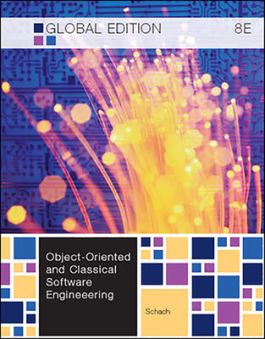Object-Oriented and Classical Software Engineering
Receive via shipping:
- Colour, print bound version of the complete text
Part One
Chapter 1 The Scope of Software Engineering
Chapter 2 Software Life-Cycle Models
Chapter 3 The Software Process
Chapter 4 Teams
Chapter 5 The Tools of the Trade
Chapter 6 Testing
Chapter 7 From Modules to Objects
Chapter 8 Reusability and Portability
Chapter 9 Planning and Estimating
Part Two
Chapter 10 Key Material from Part A
Chapter 11 Requirements
Chapter 12 Classical Analysis
Chapter 13 Object-Oriented Analysis
Chapter 14 Design
Chapter 15 Implementation
Chapter 16 Postdelivery Maintenance
Chapter 17 More on UML
Chapter 18 Emerging Technologies
Chapter 2 Software Life-Cycle Models
Chapter 3 The Software Process
Chapter 4 Teams
Chapter 5 The Tools of the Trade
Chapter 6 Testing
Chapter 7 From Modules to Objects
Chapter 8 Reusability and Portability
Chapter 9 Planning and Estimating
Part Two
Chapter 10 Key Material from Part A
Chapter 11 Requirements
Chapter 12 Classical Analysis
Chapter 13 Object-Oriented Analysis
Chapter 14 Design
Chapter 15 Implementation
Chapter 16 Postdelivery Maintenance
Chapter 17 More on UML
Chapter 18 Emerging Technologies
Chapter 4 Teams
Chapter 5 The Tools of the Trade
Chapter 6 Testing
Chapter 7 From Modules to Objects
Chapter 8 Reusability and Portability
Chapter 9 Planning and Estimating
Part Two
Chapter 10 Key Material from Part A
Chapter 11 Requirements
Chapter 12 Classical Analysis
Chapter 13 Object-Oriented Analysis
Chapter 14 Design
Chapter 15 Implementation
Chapter 16 Postdelivery Maintenance
Chapter 17 More on UML
Chapter 18 Emerging Technologies
Chapter 6 Testing
Chapter 7 From Modules to Objects
Chapter 8 Reusability and Portability
Chapter 9 Planning and Estimating
Part Two
Chapter 10 Key Material from Part A
Chapter 11 Requirements
Chapter 12 Classical Analysis
Chapter 13 Object-Oriented Analysis
Chapter 14 Design
Chapter 15 Implementation
Chapter 16 Postdelivery Maintenance
Chapter 17 More on UML
Chapter 18 Emerging Technologies
Chapter 8 Reusability and Portability
Chapter 9 Planning and Estimating
Part Two
Chapter 10 Key Material from Part A
Chapter 11 Requirements
Chapter 12 Classical Analysis
Chapter 13 Object-Oriented Analysis
Chapter 14 Design
Chapter 15 Implementation
Chapter 16 Postdelivery Maintenance
Chapter 17 More on UML
Chapter 18 Emerging Technologies
Part Two
Chapter 10 Key Material from Part A
Chapter 11 Requirements
Chapter 12 Classical Analysis
Chapter 13 Object-Oriented Analysis
Chapter 14 Design
Chapter 15 Implementation
Chapter 16 Postdelivery Maintenance
Chapter 17 More on UML
Chapter 18 Emerging Technologies
Chapter 11 Requirements
Chapter 12 Classical Analysis
Chapter 13 Object-Oriented Analysis
Chapter 14 Design
Chapter 15 Implementation
Chapter 16 Postdelivery Maintenance
Chapter 17 More on UML
Chapter 18 Emerging Technologies
Chapter 13 Object-Oriented Analysis
Chapter 14 Design
Chapter 15 Implementation
Chapter 16 Postdelivery Maintenance
Chapter 17 More on UML
Chapter 18 Emerging Technologies
Chapter 15 Implementation
Chapter 16 Postdelivery Maintenance
Chapter 17 More on UML
Chapter 18 Emerging Technologies
Chapter 17 More on UML
Chapter 18 Emerging Technologies
McGraw Hill Connect is an award-winning digital teaching and learning solution that empowers students to achieve better outcomes and enables instructors to improve course management efficiency.
High-Quality Course Material
Our trusted solutions are designed to help students actively engage in course content and develop critical higher-level thinking skills while offering you the flexibility to tailor your course to the ways you teach and the ways your students learn.
Assignments & Automatic Grading
Connect features a question bank that you can select from to create homework, practice tests and quizzes. Dramatically reduce the amount of time you spend reviewing homework and grading quizzes, freeing up your valuable time to spend on teaching.
Analytics & Reporting
Monitor progress and improve focus with Connect’s visual and actionable dashboards. Reports are available to empower both instructors and students with real-time performance analytics.
Seamless Integration
Link your Learning Management with Connect for single sign-on and gradebook synchronization, with all-in-one ease for you and your students.


